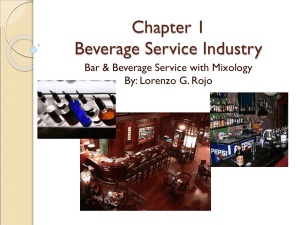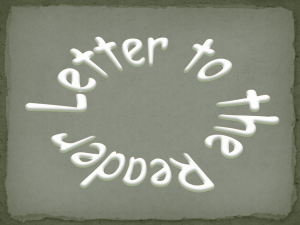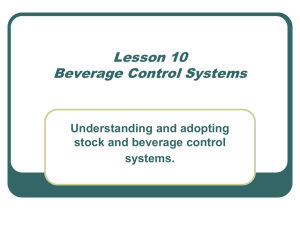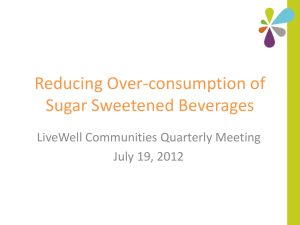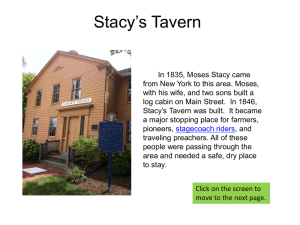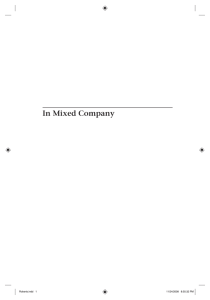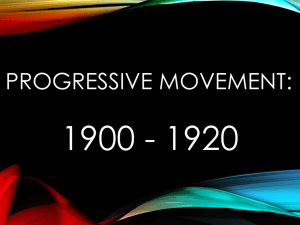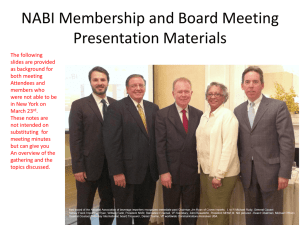Taverns
advertisement
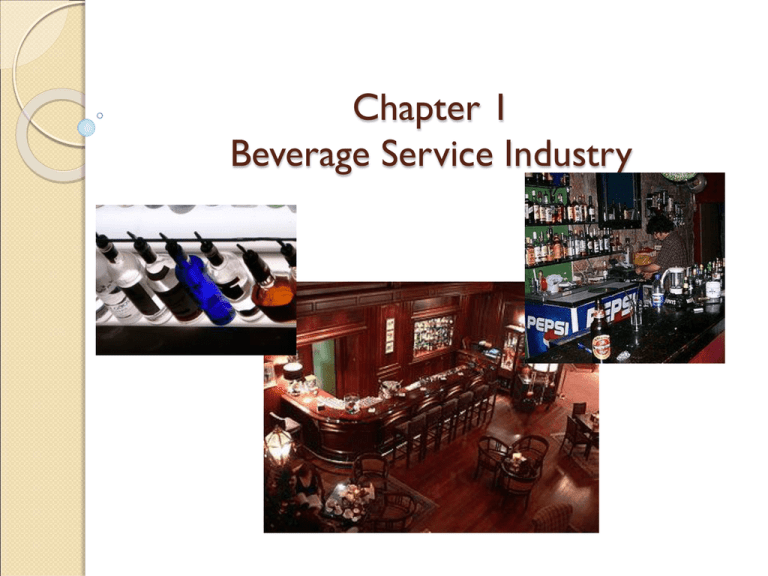
Chapter 1 Beverage Service Industry Definition: Bars – are establishments or businesses that primarily offer beverages, food and sometimes entertainment and other services to its customers. Beverage Service Industry – is an industry comprising of establishments or businesses that offer primarily beverages, foods and sometimes entertainment and other services. The term “bar” is derived from the specialized counter on which drinks are served and is a synecdoche applied to the whole of the drinking establishment. Bar (also called a pub or tavern) is a business that serves alcoholic beverages such as beer, liquor, and mixed drinks for consumption on the premises. History: Can be traced back to the time of Sumerians (4000 BC) through written records. Sumerians were considered the most progressive group of people. Some part of Sumer is the present Iraq. ◦ Sumerians were skilled traders, farmers and craftsmen. ◦ They invented the wheel, cuneiform writing system, arithmetic, military, first true city states, agriculture and irrigation. Taverns – were places serving beverage particularly “ale” and places for social gatherings. ◦ Derived from the Latin term taberna and the Greek taverna, whose original meaning was a shed or workshop. ◦ In England, tavern keeper was traditionally a woman, called ale wives in the early 13th century. ◦ By the 19th century the word tavern had evolved into the current term being public house or pub house or pub. Empire Era 3200 – AD 476 In ancient Egypt, a papyrus warns “do not get drunk in taverns… for fear that people repeat words which may have gone out of your mouth with out you being aware of being uttered them.” ◦ An indication that early people already knows the effects of alcohol to the body and mind. Ancient Greece (1100 BC), establishments serving foods and beverages includes Lesches – serving fine food and beverages, and Taverns – places for the poor. Greeks travel for religion, sports or games and to conquer lands. Ancient Rome (500 BC – 476 AD), where Romans almost conquered already all parts of Europe. Romans travel for trade, religion, pleasure or relaxation, and for political reasons. In the city of Pompei, 118 bar or taverns were discovered. Decline and Revival (AD 476 – AD 1300), travel and tourism ceased and primarily travel became limited for religious purposes only. The church took over the job of feeding and housing the travelers. They created xenodocheions or a place to house travelers which means inn. Renaissance (AD1350 – AD 1600), roads became safe again, trade and travel increased. Ale house or taverns reappeared along trade routes. The rise of the middle class in the economic life in Europe. Early Modern (AD 1600 – AD 1800), the introduction of stagecoaches became the means of transportation. Post houses were built along stagecoach routes and serve as a place for food and drinks and accommodation for travelers. Post houses is also considered in today as gasoline stations where tired horses were changed for fresh horse to continue a fast travel. Spinning jenny Invention of locomotive Growth of Factory System Man viewed as part of machines The Industrial Era (1800), the development of rail travel, in Europe, taverns became a permanent establishments. ◦ Other versions of tavern in Europe: Le Chat Noir, today Le Chat Noir, 1906 Inns Pubs Cabaret American Taverns: ◦ Taverns served as a place or rendezvous for revolutionaries. ◦ Taverns were brought by British to America: ◦ 1643 – the beginning of American Beverage Service Industry. ◦ Coles Ordinary – the 1st American tavern. ◦ In Massachusetts 1656, a town without a tavern was penalized, taverns were built near the church. Queens Head or Fraunces Tavern, 54 Pearl st cor Broad st NYC Early American Taverns: ◦ Hancock Tavern ◦ Green Dragon ◦ Raleigh Tavern ◦ Queens Head or Fraunces Tavern Green Dragon Tavern, 11 Marshall St Boston, MA 02108 Hancock Tavern, 668 Hancock Street, Quincy, MA 02170 Raleigh Tavern, Colonial Williamsburg In 1850 – taverns became large scale inns and later became hotels. They were designed like a palace but open for public use. In 1920 – Prohibition Law or 18th Amendment Law was passed – this made manufacturing, selling, and importation of alcoholic beverage in America illegal. The Prohibition Law caused large numbers of establishments stopped to operate, people lost their jobs and the government lost a large amount of revenue from the taxes generated from those establishments, and made known as a major cause of The Great American Depression. Connie’s Inn, a major speakesy In the 1920’s and 1930’s Speakeasies – places that sold illegal liquors. Moonshines – term used for illegal liquors produced during night time. Bootleggers – illegal suppliers of illegal liquors. Bathtub Gin – Gin made in the bathtub, because the preferred style of bottle didn't fit in the kitchen sink. Rumrunners – alcohol smugglers On 1933, the 21st Amendment was passed to repeal the Prohibition Law. Dramshop Law or Third Party Liability Law This law shifted the liability for damages in the drunken driven incident from the driver who caused the accident to the server or the place that served the drink to the driver. Dram – means small drink Shop – the place that serves the drinks. Development of Beverage Industry in the Philippines San Miguel Corporation History ◦ 1890 – founded by Don Enrique Maria Barreto de Ycaza in San Miguel district in Manila, the La Fabrica de Cerveza de San Miguel, the first brewery in South East Asia. ◦ 1913 – it became a corporation and began exporting beer in Guam, Hong Kong and Shanghai. ◦ 1922 – the year which started producing soft drinks at the Royal Soft Drinks Plant. 1925 – the year that started producing ice cream at the Magnolia ice Cream Plant. 1927 – the year that started bottling of Coca Cola in the Philippines. 1938 – entered the glass industry, supplying the company’s bottling needs. 1963 – San Miguel Brewery was renamed San Miguel Corporation; the largest food, beverage and packaging company in the Philippines. The Board of Directors, San Miguel Group Corp. (SMG Corp.) Eduardo “Danding” M. Cojuangco, Jr. Chairman and CEO Ramon S. Ang, President and Chief Operating Officer (COO) Members of the Board: Estelito P. Mendoza Inigo Zobel Winston F. Garcia Menardo R. Jimenez Leo S. Alvez Egmidio de Silva Jose Pacifico M. Fajardo Jesusa Victoria Hernandez Hector L. Hofileña Carmelo L. Santiago Roberto V. Ongpin Mirzan Mahathir Alexander J. Poblador Beverage-Only Bar Serves beverage alone with no food beyond snacks Bar/Entertainment Combination Offers drinks and a range of entertainment Dancing Singing Sports Live Performances Live Band Stand up comedy Fashion Show Striptease Piano music Food and Beverage Combination Serving food with beverage usually with some kind of food service. Bar and Restaurant Service Bars Hotel Beverage Operation Three or more bars in one roof with different purpose and ambience. Lobby bar Coffee shop Cocktail lounge/piano bar Restaurant bar/service bar Disco bar/night club Videoke bar Poolside bar Pool/Sports bar Banquet bar ◦ Open bar ◦ Limited bar Mini-bar Lobby bar Disco bar/ night clubs Coffee shops Cocktail lounge/ piano bar Poolside bar Mini-bar Videoke bar Open bar set-up Limited bar set-up Airline Beverage Service Drinks served on airline passengers Cruise and Passenger Ship Beverage Service Drinks are served on cruise ship liners and passenger ship vessels Rail Beverage Service Drinks are served on rail travel passengers. Coffee Shops / Coffee Houses/ Café A place specializing on coffee and serves as a meeting place particularly for transacting business. Tea Houses/ Tea Room A small room or restaurant where beverages and light meals are served, often catering chiefly to women and the place has a sedate or subdued atmosphere. It also serves a place for business or transaction. Taverns A place of business where people gather to drink alcoholic beverages and more than likely, food is served. Public Houses / Pubs A drinking establishment which served alcoholic drinks especially beer that can be consumed on the premises, usually with a setup like home. Brew Pubs/ Micro Breweries Pubs or restaurants that brew beer in the premises. Night Club / Club A place for drinking, dancing, and entertainment which does its primary business after dark. Internet Café / Cyber Café A place where one can use a computer with internet access for a fee, usually per hour or few minutes; sometimes one can have unmetered access with a pass for a day or month, etc. It may or may not serve as a regular café with food and drinks being served. Beer Garden An open-air area where alcohol is legally served. The End

